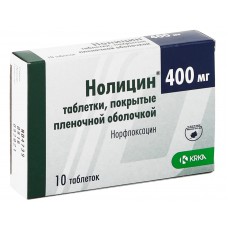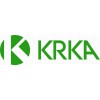Expiration date: 01/2025
Composition and form of release:
Film—coated tablets, 1 tablet contains:
norfloxacin 400 mg
excipients: povidone carboxymethyl starch sodium MCC silicon dioxide colloidal anhydrous magnesium stearate purified water (for hydration)
shell — hypromellose talc titanium dioxide dye - "sunset" yellow E110 (dispersion yellow E110) propylene glycol
in a contour cell package of 10 pcs. there are 1 or 2 packages in a box.
Description of the dosage form:
Round, slightly biconvex tablets, covered with a film shell of orange color, with a risk on one side.
Characteristic:
Antimicrobial agent from the group of fluoroquinolones.
Pharmacological action:
It affects bacterial DNA gyrase, which provides supercoiling, destabilization of the DNA chain leads to the death of microorganisms.
Pharmacokinetics:
Nolicin is rapidly, but not completely (20-40%) absorbed after ingestion, food slows down the absorption of the drug.
Cmax in blood plasma is reached after 1-2 hours and ranges from 0.8 to 2.4 micrograms / ml, depending on the dose. The low binding value of norfloxacin to plasma proteins (10-15%) and high solubility in lipids cause a large volume of distribution of the drug and good penetration into organs and tissues (kidney parenchyma, ovaries, seminal tubule fluid, prostate gland, uterus, abdominal and pelvic organs, bile, breast milk). Penetrates through the BBB and placenta. The duration of the antimicrobial effect is about 12 hours. It is slightly metabolized in the liver. T1/2 — 3-4 hours. It is excreted by the kidneys, by glomerular filtration and tubular secretion. Within 24 hours from the moment of taking 32% of the dose is excreted unchanged by the kidneys, 5-8% — in the form of metabolites with bile, about 30% of the dose is excreted.
Description of pharmacological action:
It has a bactericidal effect. It acts on the bacterial enzyme DNA gyrase, which provides supercoiling of DNA and, thus, the stability of bacterial DNA. Destabilization of the DNA chain leads to the death of bacteria. It has a wide spectrum of antibacterial action. Sensitive: Staphylococcus aureus (including strains of Staphylococcus spp., resistant to methicillin), Staphylococcus epidermidis, Neisseria gonorrhoeae, Neisseria meningitidis, Escherichia coli, Citrobacter spp., Klebsiella spp., Enterobacter spp., Hafnia alvei, Proteus spp. (indole-positive and indole-negative), Salmonella spp., Shigella spp., Yersinia enterocolitica, Campylobacter jejuni, Aeromonas spp., Plesiomonas spp., Vibrio cholerae, Vibrio parahaemolyticus, Haemophilus influenzae, Chlamydia spp., Legionella spp. Enterococcus faecalis, Streptococcus spp. (pyogenes, pneumoniae and viridans), Serratia marcescens, Pseudomonas aeruginosa, Acinetobacter spp., Mycoplasma hominis, Mycoplasma pneumoniae, Mycobacterium tuberculosis, Mycobacterium fortuitum have different sensitivity to the drug.
Indications:
Infectious and inflammatory diseases caused by pathogens sensitive to the drug:
- acute and chronic infectious diseases of the urinary tract (urethritis, cystitis, pyelonephritis)
- genital infections: cervicitis, endometritis, chronic bacterial prostatitis
- uncomplicated gonorrhea
- bacterial gastroenteritis (salmonellosis, shigellosis)
- prevention of recurrent urinary tract infections
- prevention of sepsis in patients with neutropenia
- prevention of travelers' diarrhea.
Contraindications:
- hypersensitivity to norfloxacin, the components of the drug and other quinolones
- glucose-6-phosphate dehydrogenase deficiency
- children and adolescents (up to 18 years)
- pregnancy
- breastfeeding period.
With caution:
- atherosclerosis of cerebral vessels
- violation of cerebral circulation
- epilepsy, epileptic syndrome
- renal/hepatic insufficiency
- the presence of an allergic reaction to acetylsalicylic acid.
Use during pregnancy and lactation:
The safety of use during pregnancy and during breastfeeding has not been studied. Appointment during pregnancy is possible only for vital indications, when the intended benefit to the mother exceeds the potential risk to the fetus. If it is necessary to prescribe the drug during lactation, breastfeeding should be discontinued.
Side effect:
From the digestive system: decreased appetite, bitterness in the mouth, nausea, vomiting, abdominal pain, diarrhea, pseudomembranous enterocolitis (with prolonged use), increased activity of hepatic transaminases.
From the urinary system: crystalluria, glomerulonephritis, dysuria, polyuria, albuminuria, urethral bleeding, increased urea and plasma creatinine.
From the nervous system: headache, dizziness, fainting, insomnia, hallucinations. In elderly patients, fatigue, drowsiness, anxiety, irritability, fear, depression, tinnitus are possible.
From the cardiovascular system: tachycardia, arrhythmias, decreased blood pressure, vasculitis.
Allergic reactions: rash, itching, urticaria, edema, malignant erythema exudate (Stevens-Johnson syndrome).
From the musculoskeletal system: arthralgia, tendinitis, tendon tears (usually in combination with contributing factors).
From the hematopoietic system: eosinophilia, leukopenia, decreased hematocrit.
Other: candidiasis.
Drug interaction:
With the simultaneous use of norfloxacin and theophylline, the concentration of theophylline in the blood plasma should be monitored and its dose adjusted, since norfloxacin reduces theophylline Cl by 25% and the development of corresponding undesirable side effects may be observed.
Reduces the effect of nitrofurans.
Norfloxacin can enhance the therapeutic effect of cyclosporine and warfarin, in some cases, when using norfloxacin with cyclosporine, an increase in serum creatinine concentration was observed, therefore, control of this indicator is necessary in such patients.
Simultaneous use of norfloxacin and antacids containing aluminum or magnesium hydroxide, as well as preparations containing iron, zinc, sucralfate, reduces the absorption of norfloxacin (the interval between their intake should be at least 2 hours).
Simultaneous use with drugs that reduce the seizure threshold can lead to the development of epileptiform seizures.
Concomitant use with GCS may increase the risk of tendinitis or cases of tendon rupture.
Norfloxacin may enhance the therapeutic effect of hypoglycemic drugs (sulfonylurea derivatives).
Simultaneous administration of norfloxacin with drugs that have the potential to lower blood pressure can cause a sharp decrease in it. In this regard, in such cases, as well as when administered simultaneously with barbiturates and other drugs for general anesthesia, heart rate, blood pressure and ECG indicators should be monitored.
Method of administration and dosage:
Inside, 1 hour before or 2 hours after a meal, with a sufficient amount of liquid. The average recommended dose is 400 mg 2 times a day. The duration of therapy is from 7 to 14 days, if necessary, longer therapy is carried out.
In chronic bacterial prostatitis — 400 mg 2 times a day for 4-6 weeks or more.
With uncomplicated gonorrhea — at a dose of 800-1200 mg once or 400 mg 2 times a day for 3-7 days.
With bacterial gastroenteritis (shigellosis, salmonellosis) — 400 mg 2 times a day for up to 5 days.
For the prevention of travelers' diarrhea — 400 mg per day 1 day before departure, during the entire duration of the trip and 2 days after its end (but no more than 21 days).
For the prevention of sepsis in patients with neutropenia — 400 mg 2 times a day for 8 weeks.
In acute uncomplicated cystitis — 400 mg 2 times a day for 3-5 days.
For the prevention of recurrent urinary tract infections with frequent exacerbations (more than 3 episodes per year or more than 2 — for six months) — 200 mg once a day (at night) for a long time (from 6 months to several years).
Patients with impaired renal function with creatinine Cl > 20 ml / min do not need to adjust the dosage regimen.
Patients with renal insufficiency with creatinine Cl values < 20 ml / min (or serum creatinine level > 5 mg / 100 ml) and patients on hemodialysis are prescribed half of a single therapeutic dose of the drug 2 times a day or a full dose of the drug 1 time a day.
Overdose:
Symptoms: nausea, vomiting, diarrhea. In severe cases — dizziness, drowsiness, "cold" sweat, convulsions, puffiness of the face without changing the main hemodynamic indications.
Treatment: gastric lavage, adequate hydration therapy with forced diuresis and symptomatic therapy. It requires examination and observation in a hospital for several days. There is no specific antidote.
Special instructions:
During treatment with norfloxacin, patients should receive a sufficient amount of fluid (under the control of diuresis).
During therapy, an increase in the prothrombin index is possible (during surgical interventions, the state of the blood clotting system should be monitored).
During treatment with norfloxacin, exposure to direct sunlight should be avoided.
If there is pain in the tendons or at the first signs of tendovaginitis, it is necessary to cancel the drug. During therapy with norfloxacin, it is recommended to avoid excessive physical exertion.
In the presence of an allergic reaction to acetylsalicylic acid, azo dye E110, can cause a hypersensitive reaction, up to bronchospasm.
It is necessary to be careful when driving a car and engaging in other potentially dangerous activities that require increased concentration and speed of psychomotor reactions (especially when using ethanol at the same time).



